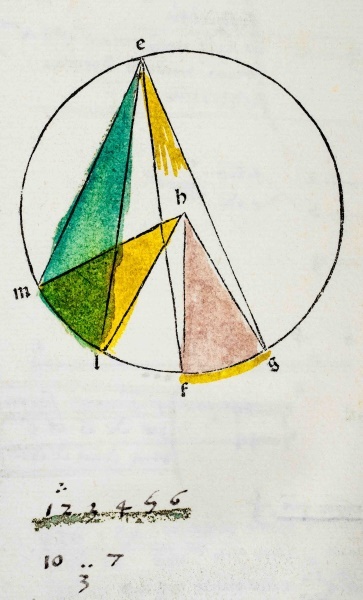Euclid: Elements of Geometry
The Greek word elementa, or “elements,” used in this title is the same word used in Greek for "letters in an alphabet." Hence, Elementa Geometrica is to mathematics what letters are to vocabulary. Euclid’s Elements is a masterpiece with two primary contributions to mathematical knowledge. First, the thirteen chapters that make up the Elements summarize approximately three hundred years of mathematical development in Greek geometry, number theory, geometrical algebra, and solid geometry (and thus include the mathematical influences of Babylonia and Egypt). Second, in the Elements, Euclid is credited with the introduction of mathematics as a deductive science. Before Euclid, the Greeks based their reasoning on unspecified intuitions. Euclid introduced definitions, axioms, and postulates into mathematical reasoning and then demonstrated how to produce results logically from the axioms, postulates, and previous results.
Euclid’s Elements contains many celebrated ideas and constructions. For example, Euclid’s fifth postulate, the parallel postulate, is particularly famous. Only in the past two hundred years have non-Euclidean geometries been constructed in which the parallel postulate is not assumed. Euclid is also credited with a famous proof of the Pythagorean Theorem, which appears in the Elements. The proof is remarkable for its logical sophistication; unfortunately, Euclid gives no clue as to how the Pythagorean Theorem was discovered or how the early Greeks had confidence in the relation. Further, Euclid’s proof of the infinity of primes is celebrated as one of the great early achievements in logic. A common misconception is that the Elements are primarily devoted to the study of geometry. Geometry or algebraic relations derived by geometric constructions do provide the material for the first six chapters and it is remarkable that this material can be recognized today in the high school geometry curriculum. But the thirteen chapters contain much more, as illustrated by the proof of the infinity of primes.
Little is known about the life of Euclid except that around 300 BC he served as head of the school of mathematics at University of Alexandria. Historians assume he was trained in Athens by students of Plato. Original Euclid manuscripts do not exist. This 1482 publication by Erhard Ratdolt is the first publication of Euclid’s Elements. Ratdolt, known for his achievements in publishing scientific works in astronomy and mathematics as well as his elegant work with missals, liturgical works, and calendars, is credited with an invention to print geometric diagrams in order to publish Elements. It is known that Ratdolt used a medieval translation due to Campanus, which is probably based on a revision originating with Theon of Alexandria (335-305 AD). An edition of Euclid’s Elements that predates Theon of Alexandria was found during the nineteenth century in the Vatican library, and analysis of this older edition verifies that Euclid’s original manuscript has undergone revisions.
—Paul Eloe, PhD, Professor, Mathematics

